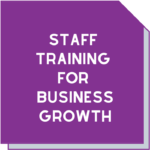THE ULTIMATE GUIDE TO TRAINING IN THE LAB Part 2
 In our last article we looked at why you need a training plan and what you should consider when developing one.
In our last article we looked at why you need a training plan and what you should consider when developing one.
This week, we’re looking at the best ways to deliver that knowledge. Training isn’t a one-off event. It’s a continuous process that requires monitoring and upgrading as your business environment changes.
Professional development isn’t a ‘nice to have’ – it’s critical to maintaining competitiveness and an agile workforce. And remember, this isn’t about putting everyone into a room and commencing torture by PowerPoint.
Training methods
So, you’ve done your needs assessment, gathered your data and have individual training plans that map to the current and future needs of your business. Well done!
Now you need to consider which methods of training you’re going to use. And this will depend on the training you’re offering and how people learn best. And with remote NATA assessments still a possibility, you may need to consider training your staff in this skill as well.
Since there isn’t a ‘one size fits all’ option, developing mixed modes of training delivery is usually best.
Face-to-face training
Face-to-face instruction (whether online or in person) is the method most people are familiar with. Bringing in an outside facilitator, particularly one experienced in lab practices, offers a new perspective and introduces new ideas. This is where grouping your people by abilities is particularly helpful. It also means that you will need to select your training provider carefully.
For example, our Measurement Uncertainty Made Simple course is for those with very little to a basic level of MU comprehension. However, those participants would struggle with the Measurement Uncertainty in Sampling content since this requires more experience and depth of knowledge. This will lead to frustration for the participants and potentially negative feedback for the trainer.
Sometimes you’ll need comprehensive and lengthy training that will set the base line of skills to build on. That’s why you’ll need a training provider with substantial experience in labs, quality systems and the subject matter. This means that your staff will get the training to meet their needs and that of the business and importantly, consistency of message.
Online learning
 While many face-to-face courses are being offered online, this form of learning involves PowerPoints, videos, and quizzes.
While many face-to-face courses are being offered online, this form of learning involves PowerPoints, videos, and quizzes.
A learner can work through online training content at their own pace. They will need to be self-directed and motivated to complete this training on their own and there is often a time limit for the training to be completed.
Many companies develop their own content for this purpose. You could use PowerPoints or simple video software to create components of staff onboarding such as a short welcome video. Some OH&S training can also be completed this way (although legislative requirements around this could vary between States and Territories). Our colleagues at Affirmer can help you with this type of training.
Once the course is done, provide them with an eBook comprising job aids and open-ended questions. This can be used to assess knowledge and act as an aide memoire.
Coaching or mentoring sessions
 This option includes both formal and informal coaching, mentoring or on-the-job training provided by colleagues. This peer learning approach is also useful for current staff members. Since humans tend to learn as they teach, the “teachers” will be strengthening their own understanding of concepts while sharing their knowledge.
This option includes both formal and informal coaching, mentoring or on-the-job training provided by colleagues. This peer learning approach is also useful for current staff members. Since humans tend to learn as they teach, the “teachers” will be strengthening their own understanding of concepts while sharing their knowledge.
A blended learning approach could be used here as well, with the learner completing an online or written task and receiving feedback during the coaching session.
While this approach is useful for on the job and more technical training, peer learning can be leveraged in other ways. For example, high performing staff members could run periodic small group workshops. Or an internal ‘knowledge marketplace’ could be established, connecting employees with specific skills with those seeking those skills.
As well as providing valuable learning opportunities, this is a tangible demonstration that your business values their knowledge and expertise.
Micro learning
These short, bite-sized sessions take into account the amount of time many individuals (and businesses) have available to complete learning. Instead of several hours or days, specific topics could be broken down into short videos or slides, accessed through an intranet system.
Examples of micro learning could be:
- Brief videos that staff can revisit when they need to complete common tasks
- Specific safety information relating to pieces of equipment
- A quick tutorial about recycling in the lab
- A pdf or eBook that goes into detail about a particular topic – this can be very useful for employees as a reference
- Job aids, definitions, and reminders (for example, how to change your phone message when you’re out of the office)
- Mental health information including simple exercises to relieve stress or anxiety
And micro learning need not be boring, fact-based instruction. Developing content that adds a level of gamification or competition can add incentive to take part.
Planning your training
We can break training down into various categories:
- Onboarding of new staff – explaining about the company’s culture, mission, structure, policies, and procedures
- Compliance – accreditation requirements, health and safety regulations and industry standards
- Product knowledge – understanding of the range of products and services your company produces or offers, their features and benefits
- Customer service – how your business interacts with customers, how it handles complaints and documented requirements
- Job specific or technical skills required to successfully perform daily tasks
- Soft skills training – active listening, leadership, communication skills and conflict resolution.
You will need to train your staff in all these aspects which is why training checklists are so important.
Another option is a job role library. Each role can map to a skills library which then links to a training content library. For example, a lab manager’s skills library could include planning and organising, business development and how to manage teams. That could lead them to a content library that includes handling staff complaints, emotional intelligence, and planning.
Creating proper pathways

Remember, pointing employees at a selection of training on an intranet doesn’t qualify as a learning pathway. This is not active learning, and your carefully curated selection of video snippets will likely be ignored.
Active learning experiences allow participants to discuss and reflect on what they’ve learned. It allows them to interact with the material such as through role plays and is more likely to stick with them once the training is over.
This is also extremely important when it comes to applying what they’ve learned. To retain that information, they need to apply it in context as soon as possible.
Plus, this information also needs to be reinforced over time. Hermann Ebbinghaus coined the phrase the ‘forgetting curve’. He discovered that students forgot 56% of what they had learned within an hour, 66% was lost after a day and 75% after six days.
Rinse and repeat
Spaced repetition of information is critical to flattening the curve and ensuring retention of that information. Reminders to staff members over a period (for example, a week later, a month later etc.) will help to cement that learning.
In fact, this is one of the reasons we do a follow up with all our participants a couple of weeks after our training courses.
The final word
As you can see from this overview, there’s a lot of work that goes into creating an effective training program for business growth.
As well as providing a range of relevant, cost-effective courses, we can help you with gap analysis and mentoring support. Contact Maree (0411 540 709), Diane (0402 012 781) or email info@masmanagementsystems.com.au to set up a confidential discussion.
Remember, you don’t have to do this alone!
Download the article The Ultimate Guide to training in the lab part two
You can also check out our detailed guide about ISO 17025.





